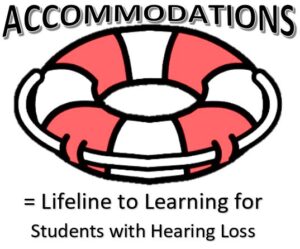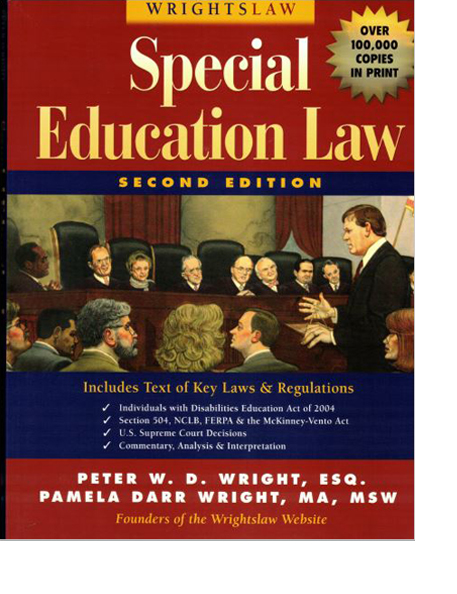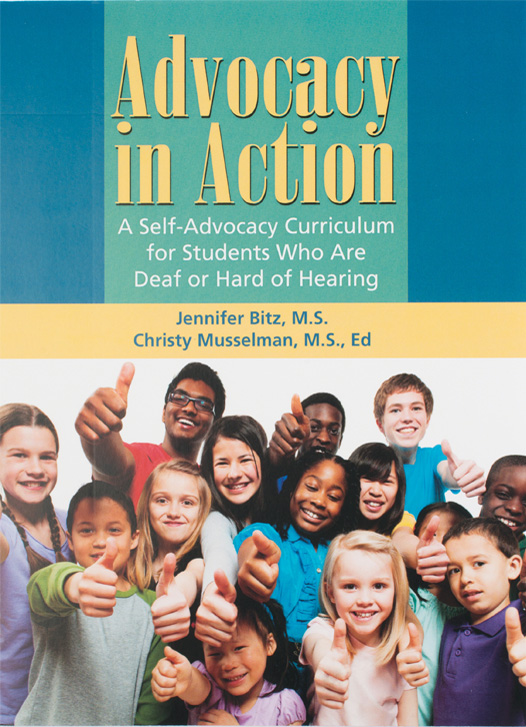Related Products
For Professionals
- Amplification
- Assessment of Student Skills, Challenges, Needs
- Early Childhood: Infants, Toddlers, Preschool
- Hearing Loss – Identification, Impact and Next Steps
- IDEA Law Summary Information
- Language and Speech Development Issues
- Legal Issues in Serving Children with Hearing Loss
- Listening (Auditory Skills) Development
- Planning to Meet Student Needs
- Self-Advocacy Skills for Students with Hearing Loss
- Self-Concept: How the Child with Hearing Loss Sees Himself
- Social Skills
- Speech Perception & Learning
Related Teacher Tools Takeout Items
Accommodations – Lifeline to Equal Access
 Classroom hearing assistance technology, interpreting services and captioning are often viewed as expensive within tight school district budgets and special accommodations are often seen as a hassle. Yet without these necessary provisions students who are deaf or hard of hearing are discriminated against due to a lack of equal access to school communication. Sometimes school teams with limited experience in the needs of students with hearing loss choose to refuse to provide necessary accommodations, take a ‘wait and see’ attitude, or downplay their importance if any difficulties arise in their consistent use. DHH professionals and families of children with hearing loss must be prepared to respond.
Classroom hearing assistance technology, interpreting services and captioning are often viewed as expensive within tight school district budgets and special accommodations are often seen as a hassle. Yet without these necessary provisions students who are deaf or hard of hearing are discriminated against due to a lack of equal access to school communication. Sometimes school teams with limited experience in the needs of students with hearing loss choose to refuse to provide necessary accommodations, take a ‘wait and see’ attitude, or downplay their importance if any difficulties arise in their consistent use. DHH professionals and families of children with hearing loss must be prepared to respond.
The primary difference between students with hearing loss and their typically hearing peers is that they do not access verbal communication as fully as others. Accommodations are truly the lifeline to our students being able to achieve and progress as effectively as peers.
Accommodations are sometimes seen as ‘being taken care of’ by making a quick statement on the IEP or perhaps checking off some boxes. Since the learning issues caused by hearing loss are due to decreased access to verbal information, accommodations – including appropriate auxiliary aids and services – are intended to ‘level the playing field.’ Accommodations need to be considered carefully, discussed thoroughly, implemented consistently and then monitored to ensure that they are indeed, providing equal access to classroom communication.
|
|
Unless appropriate and effective accommodations are provided, the student with hearing loss will be discriminated against in the classroom as they are expected to perform as well as other students without being provided the same information. Of course discrimination is a harsh word and educators do not intentionally discriminate against any student. In the US, the Americans with Disabilities Act requires schools to ensure that communication for students with hearing loss is as effective as communication for others. Accommodations, specifically auxiliary aids and services must be provided to afford these students an equal opportunity to obtain the same result, to gain the same benefit, or to reach the same level of achievement as that provided to others. Whenever accommodations are not provided, not used consistently, or not effective the student does not have an equal opportunity to achieve as their peers.
How well a student is able to perceive speech in a classroom will impact educational performance. Students who are deaf or hard of hearing are at high risk for delayed vocabulary acquisition, vocabularies of smaller size and sophistication, struggling with the English verb system, lack of access to morphological information. This overall may appear insignificant (low average performance per normed assessment) but it can significantly affect academic achievement.
Auditory Learner Access Needs
|
A Functional Listening Evaluation conducted on (DATE) indicated that XXX is a student with an educationally significant hearing loss, which limits access to the curriculum. XXX’s hearing aids do not restore normal hearing and thereby do not provide sufficient access to classroom content. XXX’s comprehension is also significantly challenged in the presence of background noise at levels typical of a classroom. Hearing Assistive Technology (§300.5 under IDEA), recommended by an educational audiologist (a related service provider under IDEA; §300.34) is required in order for this student to access curriculum and to receive a free and appropriate public education (FAPE). Specifically, the following Hearing Assistive Technology is recommended to supplement her hearing aids: …. * |
Students who are hard of hearing do not have normal hearing restored by hearing aids or cochlear implants. Under typical classroom listening conditions they will ALWAYS have to put forth more effort, to ultimately perceive fragmented communication. With more effort put toward listening, there are fewer cognitive resources available for the student to recognize all of the words, comprehend them and integrate them into their knowledge base. This is why a student with hearing loss typically requires information to be repeated 3 times when a typically hearing student would need to have it presented only once. While a student may ‘communicate normally’ in a 1:1 conversation across a small table in a quiet room (3 feet), that ability is not predictive of how accurately the student will be able to listen at a distance (class discussion) and in the presence of typical levels of classroom noise. Similarly, hearing thresholds on an audiogram are also not predictive of speech perception as only 39% of the ability to understand speech in noise can be predicted from hearing thresholds. Hearing assistance technology (HAT), specifically personal FM/DM systems, are the ONLY means to optimize the auditory signal a student receives.
(*Based on information from Kym Meyer, Educational Audiologist)
Visual Learner Access Needs
The academic information received by visual communicators is totally reliant upon the skills of their sign language interpreter or cued speech transliterator. A 2005 study evaluated 2100 educational interpreters in the US using the Educational Interpreters Performance Assessment. The results found that about 60% of the interpreters evaluated had inadequate skills to provide full access. The study suggested that many students receive interpreter services that seriously hinder reasonable access to class curriculum and social interaction. A 2009 study focused on the accuracy of translation as measured by number of key science words included in a CART transcript or in videos of sign interpretation. “Best” interpreters /CART providers were selected who knew the study was about accuracy were selected. Participants transcribed or signed three science videos by NASA. The accuracy interpreters for the three videos was 81%, 80.1%, 62.7%. The accuracy of the CART providers was 98.5%, 96.9%, 97.2% resulting in an average accuracy of 75% for interpreters and 97% for CART transcription. The bottom line is that sufficient “through the air” access to verbal instruction and classroom communication cannot be assumed because an interpreter or CART is provided in the classroom.
Suggestions for Determining Appropriate Accommodations
- Make the case. Impress upon the student’s classroom teacher and school team that accommodations are truly the student’s lifeline to equal communication access, and therefore the opportunity to obtain the same achievement as class peers. Obtain data to estimate the students’ level of access.
- Be consistent in your approach to recommending FM/DM/HAT hearing assistance technology. The physics of sound is immutable. To receive optimized access to verbal communication in school, students who are auditory learners need to use HAT starting with school entry and continuing as long as the student is willing to comply. Even if a teacher is loud, animated and does not move around the classroom much, the student with hearing loss will still not be receiving optimal auditory input without the use of HAT.
- Emphasize that one size does not fit all. While IDEA does not require ‘optimal’, the ADA requires equal access. This is a case where the ‘bar’ for ADA is higher than it is for IDEA. Even with HAT providing optimal auditory input, a student with hearing loss will not have normal hearing restored. Per a court case: “ADA requirements regarding students who are deaf or hard-of-hearing are different than those imposed by the IDEA.” Additional accommodations are necessary to close this gap. Because IDEA and ADA requirements are not identical, there may be some situations in which a child has accommodations as part of an IEP and also requires a 504 Plan to address the auxiliary aids and services needs per ADA.
- Grades do not matter when it comes to accommodation needs. Children who are hard of hearing or deaf WILL need accommodations. How well or how poorly they perform in the classroom is not a determinant for whether accommodations should be provided. Some students put in many more hours of homework than their peers, often sacrificing social opportunities, to earn and maintain high academic achievement. The necessity to expend these extraordinary efforts can be a sign that discrimination is occurring. The case study provided by the ADA as part of the Frequently Asked Questions described a high achieving secondary student who had an FM system but also needed CART services so that he had full access to class discussions. If a student is not found to be eligible for an IEP, then this reflects the school team’s belief that the student will be able to experience one year’s growth in one year’s time without special support. In Deal v. Hamilton Board of Education (6th Circuit, 2004), the court ruled that “meaningful educational benefit must be gauged by the child’s potentialities.” Thus, accommodations will ALWAYS be necessary, whether via an IEP, 504 Plan or both.
Response to: “He seems to be doing okay academically; I don’t think we need to get him an FM/DM system.” If a student in a wheelchair was assigned to a classroom with a narrow door would it be okay to have the student participate by sitting out in the hallway? In other words, would it be okay for him to not have to be included in a class with a door wide enough for the wheel chair because the student’s academic performance was not a concern? Ignoring auditory inclusion needs is the same issue.
- Consider communication needs situation-by-situation. This not only makes sense, it is another requirement of ADA. A form has been provided below to assist teams in these discussions.
- There is no ‘set list’ for appropriate accommodations. An Accessibility Considerations handout lists examples of auxiliary aids and services. This can be used as a starting place for discussion but should not be seen as limiting accommodation choices. Auxiliary services can include teacher inservice and progress monitoring by a specialist in DHH. The federal Every Student Succeeds Act encourages specialized instructional support providers to support literacy and collaborate with classroom teachers, thus allowing special educators to work with classroom teachers on behalf of regular education students.
- It is the school’s responsibility to ensure that the provided accommodations are effectively providing equal access to classroom communication. For students who are grade 3 and above it is suggested that they complete the Listening Inventory For Education – Revised (LIFE-R) Student Appraisal (Teacher Tools Takeout 0099, 0052, 0100) at the beginning of the year and review the results at the end of the first quarter to discuss if, with the accommodations, the student feels as though access has improved. Routine classroom observations and performance monitoring can also be helpful to determine the effectiveness of the accommodations being provided.



